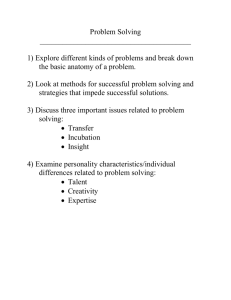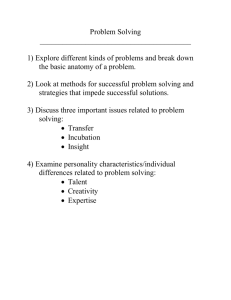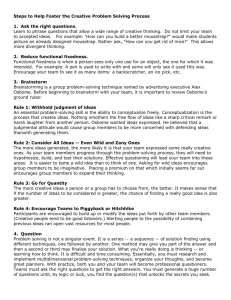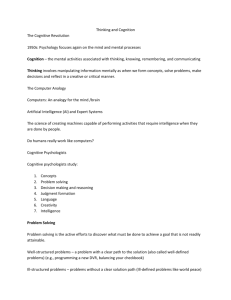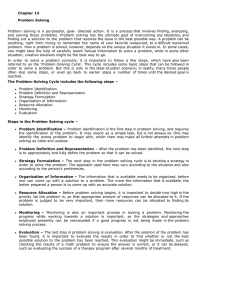Problem Solving PERTEMUAN 10
advertisement
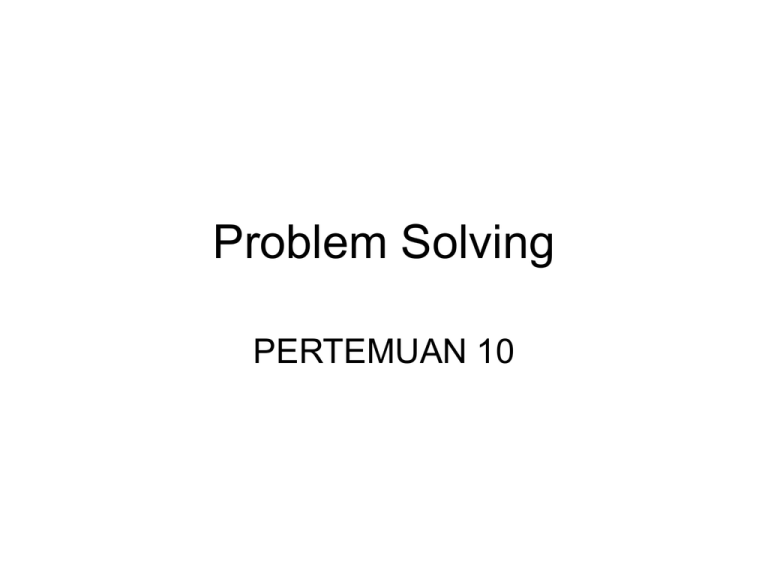
Problem Solving PERTEMUAN 10 9.1 Early research on problemsolving • A cat placed in a box with a trapdoor was not observed to show behaviour approximating thinking, but instead performed all kinds of behaviours until the appropriate response was made accidentally, the trapdoor would then open and food was available as a reward Scheerer (1963): nine-dot problem 9.2 Gestalt problem solving • • • • Representation Set Incubation Insight Insight • Wolfgang Köhler (1925), on the island of Tenerife. – He founded a colony of chimpanzees and studied their problem-solving behaviour. – one chimp named Sultan was able to use a stick to obtain some bananas that were placed on the outside of his cage. – When provided with two poles, neither of which was long enough to reach the bananas, the ape first ‘sulked’, then eventually put one pole inside the other to create a longer pole Insight • Gestalt psychologists saw problem solving as the ‘closure’ of a problem, achieved by the representation of the problem in an appropriate way. • In analogy with Gestalt theories of perception, a problem is only a problem because it is incomplete; the solution makes it complete, and finding the solution ‘closes’ the incompleteness. • Closure is accompanied by the flash of insight or ‘aha!’ experience. Incubation • Incubation: three general findings – ONLY after much time and effort are already invested – burst of insight (the “aha!” feeling) – not in final form • Five hypotheses about why incubation works – decrease fatigue – forget inappropriate sets and directions – added practice - divided attention with part of your mind still working on the problem – change occurrence of an external event that triggers a new association • e.g. waffle iron and running shoes – unconscious processing - run automatized search strategies • Incubation results in – innovation - synthesis of ideas – insight - pieces come together • Maier (1930, 1931) investigated the ‘twostring’ problem Functional fixedness • functional fixedness: the inability to use an object appropriately in a given situation because of prior experience of using the object in a different way. • Functional fixedness is a good example of stereotypical thinking and is a ‘block’ to problem solution • Duncker (1945) concerns a problem where subjects are handed a candle, a box of nails and other objects Problem-solving set • Another potential ‘block’ to problemsolving is referred to as ‘set’ which is the rote application of learned rules. • Luchins (1942) experiment: – demonstrates that some problems cannot be solved through reproductive thinking – and that our past experience can hinder problem solution An example of the water jug problem 9.3 Problem space theory of problem solving Newell and Simon (1960s) 1. Representing the problem—a problem space is constructed which includes both the initial state and the goal state, the instructions and the constraints on the problem and all relevant information retrieved from long-term memory. To assist such representation, symbols, lists, matrices, tree diagrams, graphs and visual imagery can all be used. 2. Selection of operators—operators are actions that will achieve a goal, and are used for transforming the initial state 3. Implementation of the selected operators—this results in a new current state within the problem space. 4. Evaluation of the current state—if it corresponds to the goal, a solution is reached. Tower of Hanoi Problem Problem-solving strategies • • • • Heuristics, State-action tree. Problem reduction Means-end analysis 9.4 Problem solving and knowledge • Expertise • Problem-solving by analogy 9.5 Problem solving and reasoning deficits • Impairments in attention • Impairments in abstract and conceptual thinking • Impairments in cognitive estimation • Impaired strategy formation • Deficits in everyday higher order planning Card sorting task Improving Your Problem Solving • Try – – – – – – – – novel or atypical associations working backwards solving a similar but easier problem diagramming the problem visualization brainstorming (withhold evaluation) analogies evaluating other people’s solution to other problems • read biographies – breaking the problem into sub goals • Techniques for systematizing your search – inferences - what else applies • consciously draw as many inferences as possible from the goals, given, and actions – classification of action sequences • record all actions tried • organize equivalence classes I.e. inverse actions – state evaluation • define a “quantitative” evaluation for all momentary outcomes • choose actions that have evaluations closest to goals – contradictions • derive inferences from the given that are inconsistent with the goal • avoid actions that lead to inconsistent subgoals
